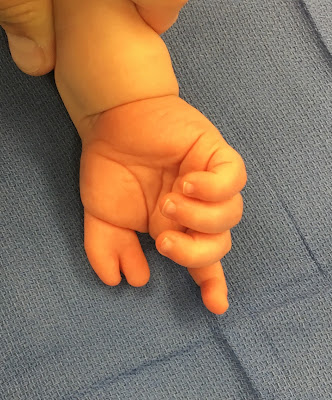I have shared my thoughts on radial polydactyly (extra thumb) a number of times- those other posts can be found at https://bit.ly/3emosGU. Radial polydactyly is a common diagnosis for those children with birth differences but each child and each extra thumb is also very different. This makes comparing children difficult and results are limited in the medical literature. I am excited to share two positive steps.
The first is that our CoULD Registry recently completed an assessment of classifications. First- what is CoULD? This is a registry that we created to enroll and follow kids with birth differences of the upper extremity. We have been enrolling kid for about 5 years and have over 3200 patients at 10 different sites. Really exciting as these patients will teach us so much and help us better understand these birth differences. Here is the website for more information:
https://kidshandregistry.com/.
Working with different sites (Ann Van Heest in Minneapolis led this study) we evaluated hundreds of children with an extra thumb to better understand the classification systems available to us- this paper will be published soon and will be an important step forward!
The second exciting potential is that we applied for a grant to further understand the genetics of radial polydactyly. While we won’t hear about the grant for another 6 months, we are super excited and have a grant team in place to move this effort forward!
Now, I would like to share the 4 year outcome of a great patient with radial polydactyly. This is type 4- meaning that the extra thumb comes from the MCP joint. These thumbs are not terribly divergent (i.e., they are not going in the opposite directions) but the surgery still required a realignment and ligament construction to make it straight and functional.
Here are the before surgery pictures:
 |
| Radial polydactyly, type 4 |
 |
| Radial polydactyly, type 4 from palm side |
Surgery entailed a carefully designed incision of the skin, removal of the extra thumb, reconstruction of the ligament, and bony alignment improvement. We placed a temporary pin and casted for 6 weeks.
 |
| Thumb polydactyly reconstruction with pin in place |
 |
| Thumb polydactyly reconstruction with pin in place |
 |
| Radial polydactyly xray in operating room with pin in place |
The patient returned recently for the 4- year followup and he is doing great. The thumb has very good but slightly decreased motion compared to the opposite side and good alignment. There is no pain. There is, as we expected, a size difference. That is impossible to correct. However, it is also very difficult to notice unless the thumbs are placed next to each other as we have done in these pictures.
 |
| Comparison of thumb size. Note the slightly smaller right thumb |
 |
|
| Thumb flexion (bend) is good but not quite the same as the normal left thumb after radial polydactyly reconstruction |
|
 |
| Alignment after radial polydactyly reconstruction |
 |
| Side view of thumb after radial polydactyly reconstruction |
Every patient is different and this is a very good outcome. We do watch as the patient grows to assure no changes to alignment or function.
Charles A. Goldfarb, MD
email: congenitalhand@wustl.edu
Please CLICK HERE to support our research.
Designate my name. Thank you!



